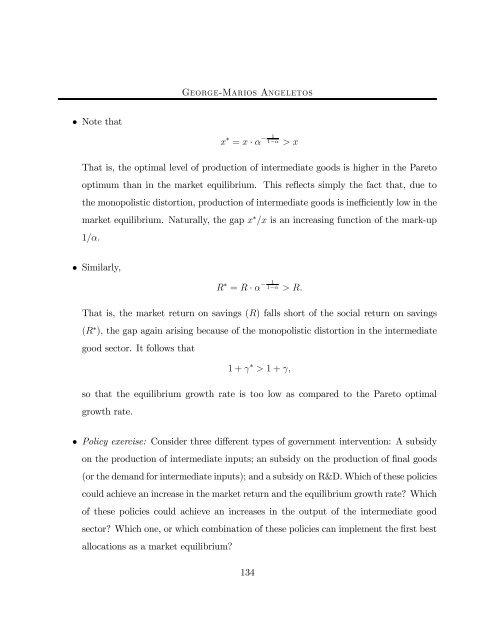14.451 Lecture Notes Economic Growth
14.451 Lecture Notes Economic Growth
14.451 Lecture Notes Economic Growth
You also want an ePaper? Increase the reach of your titles
YUMPU automatically turns print PDFs into web optimized ePapers that Google loves.
• Note that<br />
George-Marios Angeletos<br />
x ∗ 1<br />
−<br />
= x · α 1−α >x<br />
That is, the optimal level of production of intermediate goods is higher in the Pareto<br />
optimum than in the market equilibrium. This reflects simply the fact that, due to<br />
the monopolistic distortion, production of intermediate goods is inefficiently low in the<br />
market equilibrium. Naturally, the gap x ∗ /x is an increasing function of the mark-up<br />
1/α.<br />
• Similarly,<br />
R ∗ 1<br />
−<br />
= R · α 1−α >R.<br />
That is, the market return on savings (R) falls short of the social return on savings<br />
(R ∗ ), the gap again arising because of the monopolistic distortion in the intermediate<br />
good sector. It follows that<br />
1+γ ∗ > 1+γ,<br />
so that the equilibrium growth rate is too low as compared to the Pareto optimal<br />
growth rate.<br />
• Policy exercise: Consider three different types of government intervention: A subsidy<br />
on the production of intermediate inputs; an subsidy on the production of final goods<br />
(or the demand for intermediate inputs); and a subsidy on R&D. Which of these policies<br />
could achieve an increase in the market return and the equilibrium growth rate? Which<br />
of these policies could achieve an increases in the output of the intermediate good<br />
sector? Which one, or which combination of these policies can implement the first best<br />
allocations as a market equilibrium?<br />
134

















